The fifth week of listening to the Duelund-Altec Project's state-of-art Duelund CAST tinned-copper crossovers with the vintage "Stokowski" Altec's brought momentous changes in what I was hearing, and in a very satisfying way both musically and sonically.

"Stokowski" Altec loudspeakers with the exotic Duelund CAST tinned-copper crossovers.
In fact, I posted to my Facebook pals, "OMG! The Duelund-Altec Project's exotic Duelund CAST tinned-copper crossovers are sounding so good tonight it's totally freaking me out. Expect an update on the project soon."
That's not hyperbole either, as the musical & sonic performance I'm hearing from the "Stokowski" Altec's with their exotic Duelund CAST tinned-copper crossovers is simply the best, most musically satisfying, live-like audio performance I've ever heard in my listening room, or anywhere else for that matter.
I'm in complete awe at what I'm hearing, and quite literally, the performance of the Duelund CAST tinned-copper crossovers makes the lovely Jazz24 stream out of Seattle sound massively more impressive than even my superb Acoustic Sounds 45RPM records did with the stock Altec N-500-D crossovers (which were good sounding crossovers in their own right).
I am streaming Jazz24 from my aging MacBook via a DIY Art of Tone USB interconnect to a Mhdt Labs Havana USB DAC (review HERE), which receives AC via an Acoustic Revive Power Reference TripleC NCF AC power cable, and which is connected to the SPEC amp with Belden 8402 tinned-copper microphone cable interconnects.
The fact that I'm getting that revelatory level of musical & sonic performance from a modest digital front end utilizing a Jazz24 stream as a source is rather astounding. Let that sink in for a moment.
Please excuse the untidy appearance of my breadboard versions of the Duelund CAST tinned-copper crossovers in the accompanying photos, eventually it is my intent to make the crossovers as good looking as they are good sounding - all in due time!
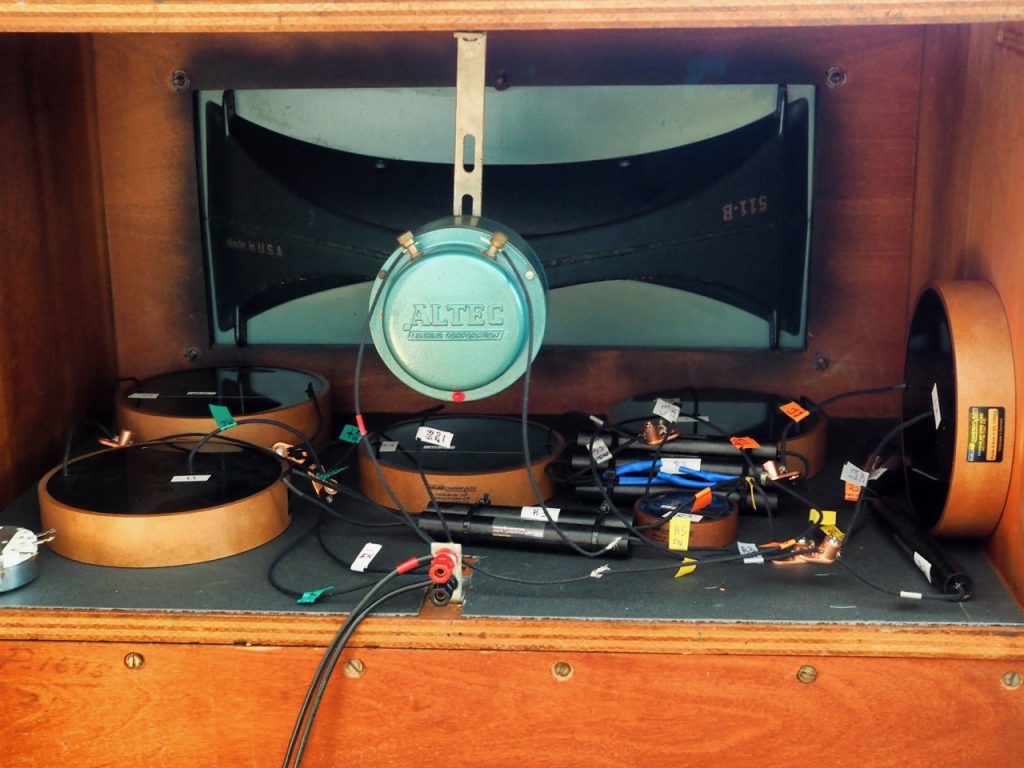
Duelund CAST tinned-copper crossover breadboards.
What I'm hearing from the Altec's and their Duelund CAST tinned-copper crossovers pushes all my musicality and sonic "buttons" to an incredible degree, and I've just been sitting here listening to music in awe of their performance.
I've waited all my life to hear this kind of performance in my listening room, and now it's here. The "Stokowski" Altec's with the Duelund CAST tinned-copper crossovers completely resets my expectations of what's possible with music reproduction in my home.
I've lost track of the exact amount of run-in time I've got on the Duelund CAST tinned-copper crossovers now, but I suppose it is somewhere in the range of 200 to 300 hours.
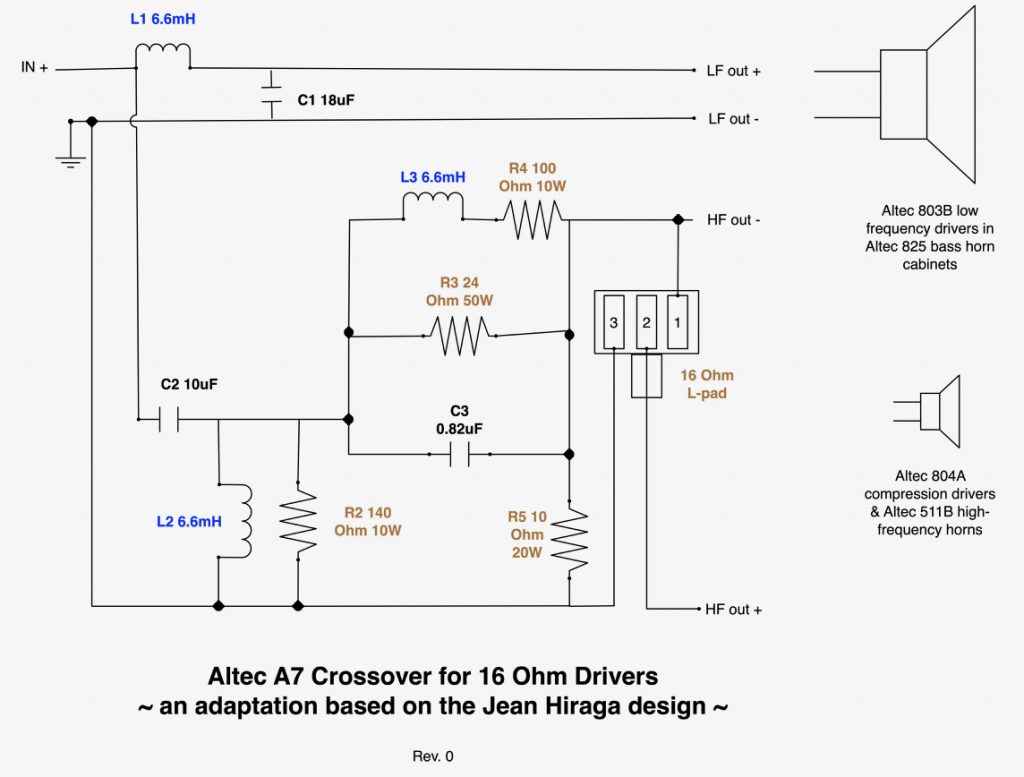
The story this week is the high-frequency Duelund CAST tinned-copper crossover circuit's rather remarkable evolution in performance.
As a reminder, these are the components that make up the HF circuit of each crossover:
- 6.6mH Duelund CAST tinned-copper inductors at L2 and L3.
- 10uF Duelund CAST tinned-copper capacitor at C2.
- 0.82uF Duelund CAST tinned-copper capacitor at C3.
- 140 Ohm 10W Duelund CAST "Jeffistor" resistor at R2.
- 24 Ohm 50W Duelund CAST "Jeffistor" resistor at R3 (comprised of five 4.8 Ohm 10W Duelund CAST "Jeffistor" resistors in series connection).
- 100 Ohm 10W Duelund CAST "Jeffistor" resistor at R4.
- 10 Ohm 20W Duelund CAST "Jeffistor" resistor at R5 (comprised of two 5 Ohm 10W Duelund CAST "Jeffistor" resistors in series connection).

Two 6.6mH Duelund CAST Sn-Cu Air Core Inductors for L2 and L3.
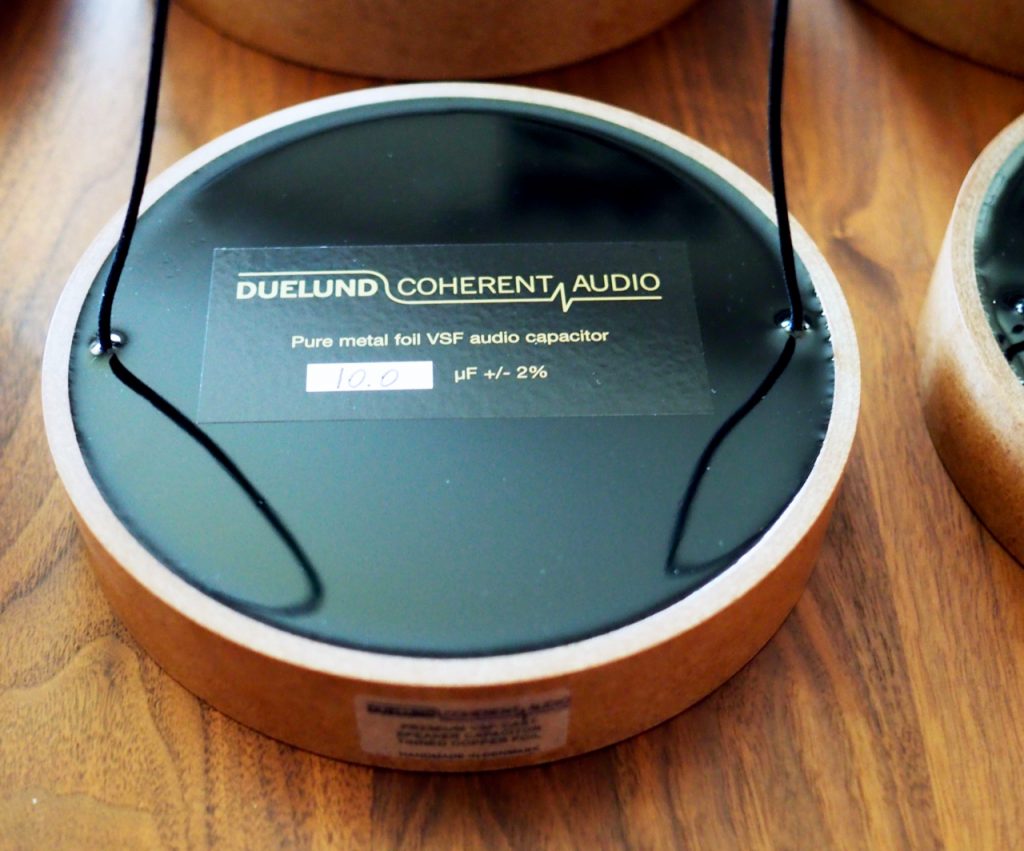
Duelund CAST Sn-Cu 10uF capacitor at C2.
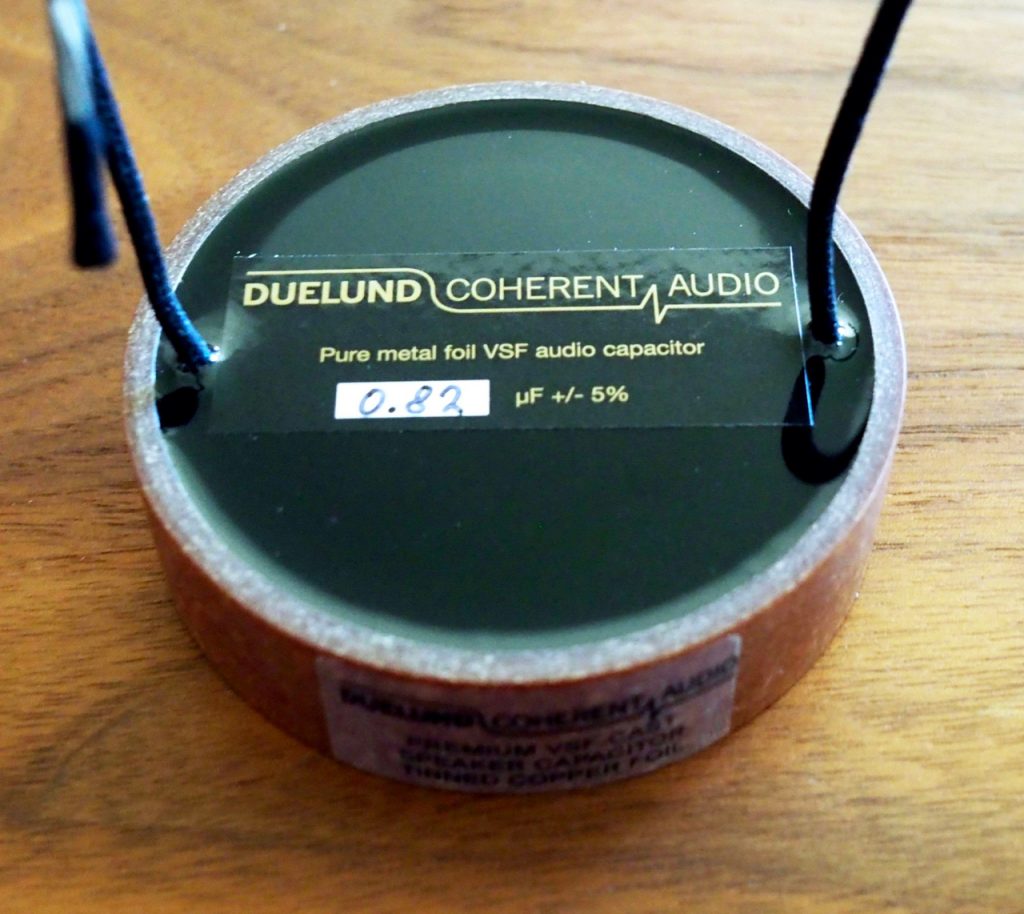
Duelund CAST Sn-Cu 0.82uF capacitor for C3.
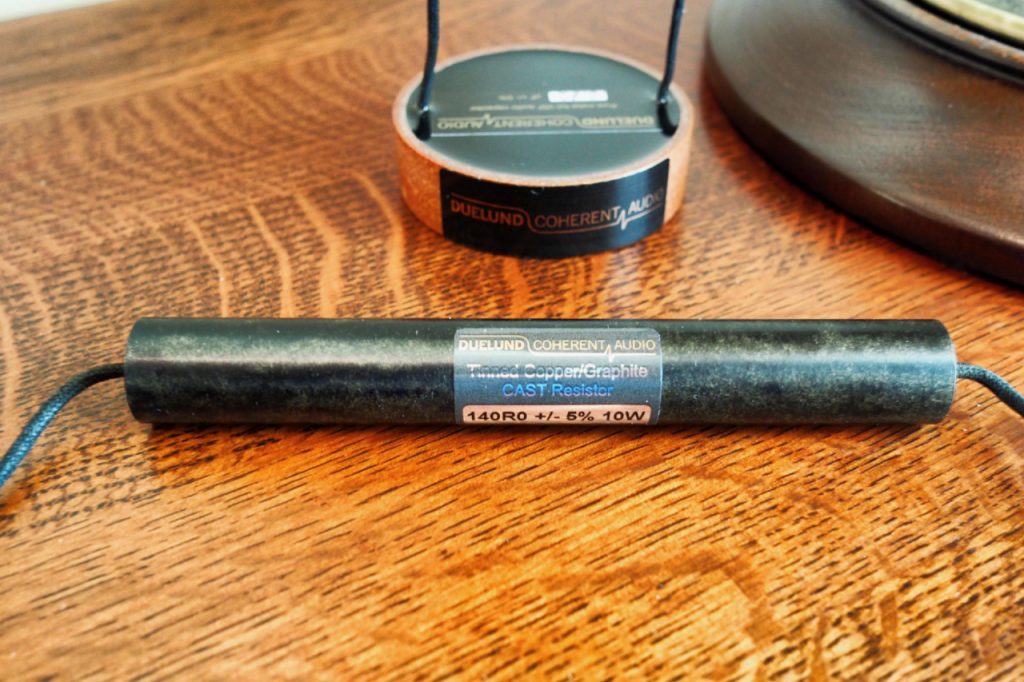
Duelund CAST carbon / Sn-Cu 140 Ohm 10W "Jeffistor" for R2.
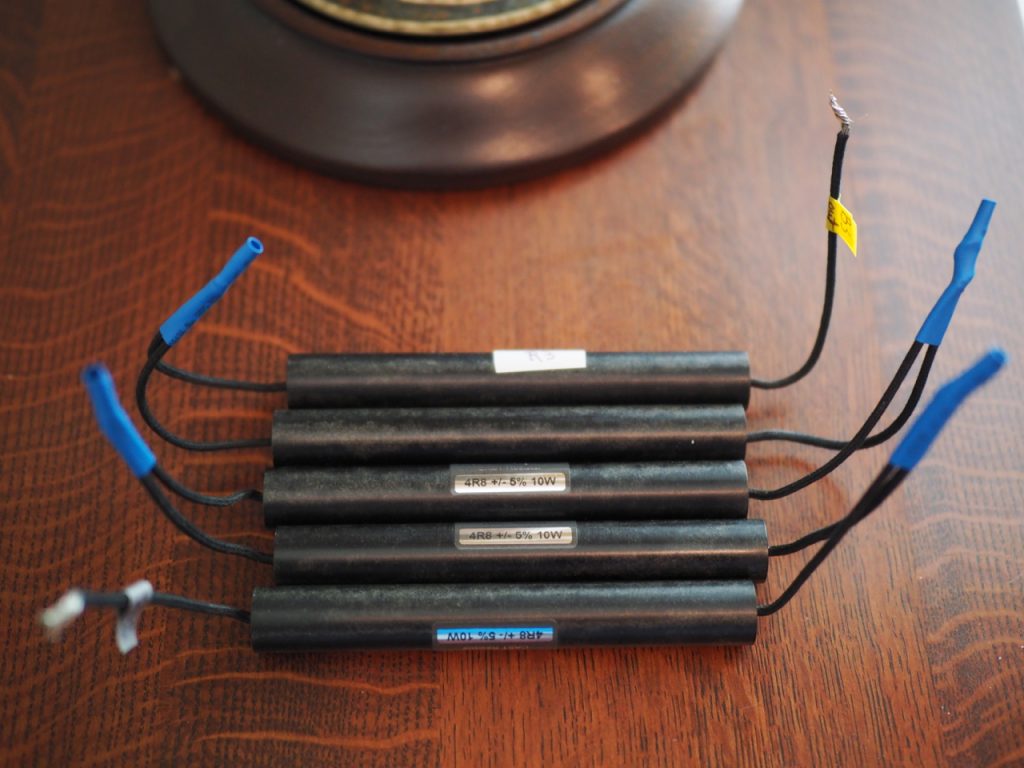
Five "Jeffistors" in series for the R3 of 140 Ohms.
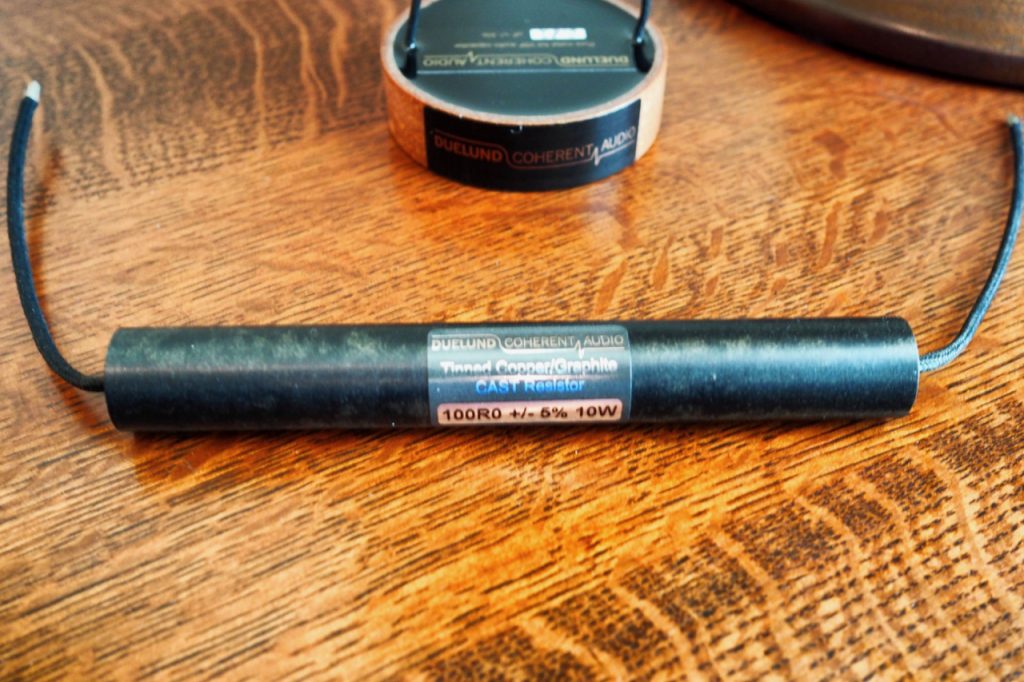
The Duelund CAST carbon / Sn-Cu 100 Ohm 10W resistor for R4.
That's a lot more components than the two components in the low-frequency crossover circuit:
- One 6.6mH Duelund CAST tinned-copper inductor for L1.
- One 18uF Duelund CAST tinned-copper capacitor for C1.
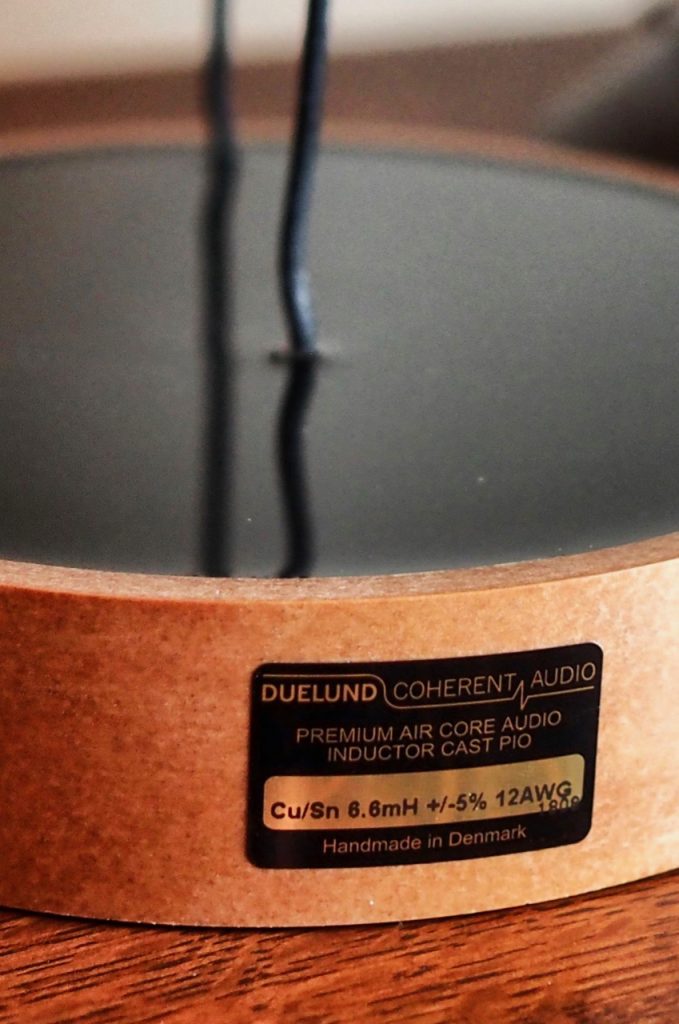
The Duelund 6.6mH CAST Sn-Cu Air Core Inductors at L1.

18uF Duelund CAST Sn-Cu capacitor at C1 with an 8 oz. coffee cup for a size comparator.
I think Alex's earlier comment hit the nail on the head when he pointed out that the amount of power going through the low-frequency crossover circuit from the amplifier is much greater than is going through the high-frequency circuit, so their rate of run-in is different, and that combined with the greater number of components in the high-frequency circuit means it's going to take longer to run-in the high-frequency circuit than the low-frequency circuit.

LF circuit is the inductor & capacitor on the far left side, everything else is the HF circuit.
That's exactly what I've been hearing as run-in time has accumulated for the crossovers, and in a quick search of an electrical engineering site HERE, for the example discussed, it says that up to 95% more power is delivered to the low-frequencies than the high-frequencies, which helps explain the different rates of run-in for the low-frequency vs high-frequency parts of the crossover circuit.
In fact, the nature of the changes in the high-frequency circuit performance meant that I was able to remove the L-pads from the circuit entirely and still get a very balanced and natural sound, something that would have been unthinkable during the first week of run-in time. You can just see an L-pad I removed sitting off to the left side in the photo above, and below is what the crossover circuit looks like without the L-pad.
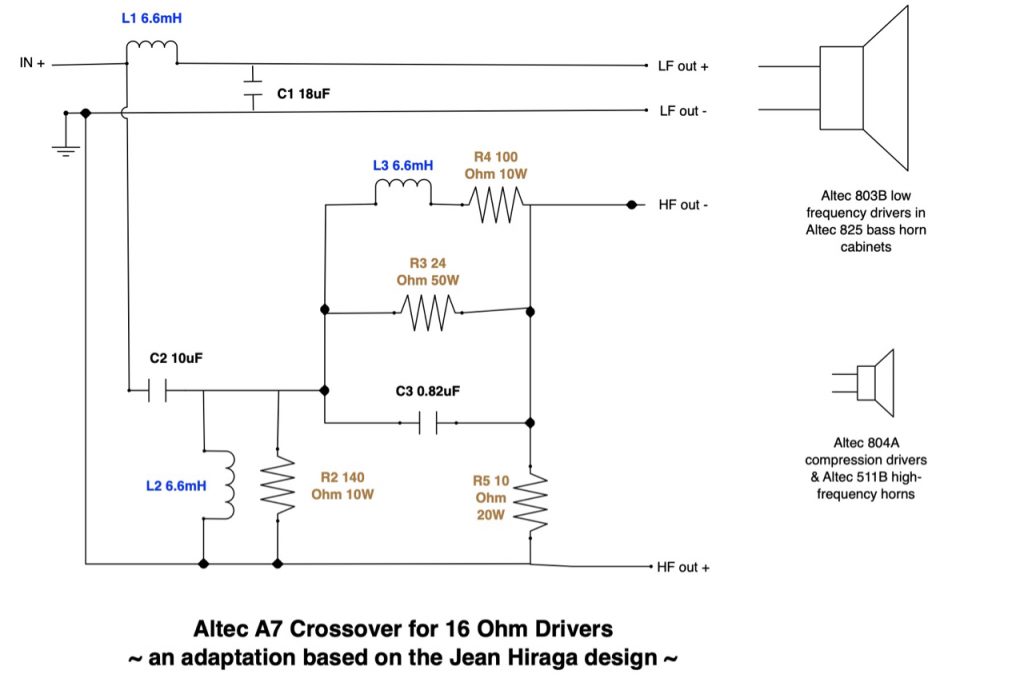
While the L-pad is a terrific tool for establishing the amount of resistance that is needed to get a well-balanced high-frequency to low-frequency presentation, the L-pad notably degraded the subjective high-frequency performance compared to the Duelund CAST carbon & tinned-copper "Jeffistor" resistors by themselves.
The downside of removing the L-pads is that I lost the adjustability of the high-frequency to low-frequency balance like the original Altec N-500-D crossovers had, but the improvement in sound quality from removing them and going with fixed resistors per the original Hiraga circuit diagram paid such big dividends in sound quality and musicality that it was easily worth the trade-off of adjustability.
Plus, once you have the low-frequency to high-frequency balance dialed in for a particular room, personal tastes, and choices of equipment, the need for adjustability diminishes greatly.

Norah Jones "Come Away With Me" LP.
While I'm really impressed with how ridiculously good the "Stokowski" Altec's and their Duelund CAST tinned-copper crossovers can make affordable digital sound, where my heart is really at is listening to vinyl records, like the Norah Jones Come Away With Me LP in the photo above, which becomes a religious-like experience through the Duelund CAST tinned-copper crossovers because it sounds so amazing.
At live like-levels, Come Away With Me is mesmerizing to listen to with the Duelund CAST tinned-copper crossovers providing the filtering for the Altec's, with Norah's voice sounding stunningly beautiful and vividly present in my listening room, with not even the slightest hint of unnatural sibilance in her voice, which is just the way I like it
Norah can really lean into it dynamically at times, and the Duelund CAST tinned-copper crossovers provide particularly impressive macro- and micro-dynamics, which makes my emotions tingle, and melody lines burst into expressive life.
The Duelund CAST tinned-copper crossovers delivers powerful and tuneful bass in Come Away With Me, with lots of space around bass drum hits, and bass lines that are full of nuance and articulation.
Overall the Duelund CAST tinned-copper crossovers provide a vivid, transparent, and nuanced presentation, that is remarkably also pleasantly rich, smooth, and natural sounding from a tonal and timbral perspective.
Make no mistake, the Duelund CAST tinned-copper crossovers are very high-resolution, but they present that high-resolution and transparency with such a relaxed ease even at live-like volume levels that it is really uncanny, and which is another trait that really endears them to me.
Another thing that really impresses me is how well the Duelund CAST tinned-copper crossovers relay the sense of acoustic space / reverb time of a recording, and the way it fills my listening room with a living, breathing, tangible sense of space.
Honestly, I can't even think of enough superlatives to articulate to you how live-like and emotionally engaging the Duelund CAST tinned-copper crossovers make the "Stokowski" Altec's sound when playing music like that of Come Away With Me.
Those hallmarks that can make home audio as engaging as live music - tone, presence, and dynamics - are so impressive with Duelund CAST tinned-copper crossovers that I still haven't found the words to fully articulate what I am hearing from them.
I think perhaps part of my struggles in being able to fully articulate their performance is because a lot of their allure is in the way they make the music feel in emotive terms, as opposed to just how their performance relates in musical and sonic terms. These are next level components!
I'll tell you a little secret: A growing number of manufacturers of high-performance audio equipment have shared with me that they have had the same sort of reaction as I have had to Frederik's line of Duelund CAST tinned-copper components in their own listening trials - that they're breakthrough level high-performance components that can rewrite what is possible in home audio - so you may be hearing more in the not to distant future about certain high-performance audio companies incorporating them into their products.
That's really good news , and I am excited to hear that word is getting out about how good the Duelund CAST tinned-copper components are musically, sonically, and emotively, and that they'll be showing up in more audio products so more people will get a chance to hear what I am hearing!
I'm going to keep this update short & sweet, as it's time to get tonight's dinner going, but I wanted to give you another glimpse into how things are shaping up, which as you can tell, is mighty fine.
I have a hunch that the Duelund CAST crossovers haven't even hit their full stride yet in terms of run-in time, so I'm going to give them plenty more run-in time until I'm sure I'm hearing them at their full potential, before I fiddle with wiring, the Cable Cooker, and such to wring out every last drop of performance.
Ok, that's it for now. As always, thanks for stopping by, and may the tone be with you!






























